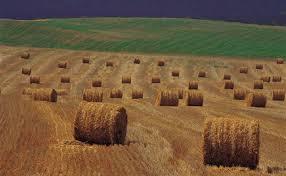Think Ahead to Meet Winter Hay Needs
Hay availability in Kentucky may be short this winter because of multiple, compounded issues. The variability of yield, quality and number of cuttings indicate the hay supply could get tight. It is important to protect the hay crop you have and use it wisely—that smart conservation and planning will help make hay last longer through the winter.
Due to weather events—droughts and floods—both hay quality and yield are down. To ensure an adequate amount of hay, farmers should enact several measures. Store hay inside a barn, where it will remain dry. Remember to store hay in barns that have access in all types of weather. If that is not feasible, cover with a tarp to protect from the elements. Buy hay by the ton if possible and require certified stamped weight.
Testing is the first step to knowing how much will be necessary to meet the nutritional needs of the animals they feed, from horses to cattle to goats. Hay is tested primarily for crude protein, acid detergent fiber, neutral detergent fiber, total digestible nutrients and relative feed value. Get your hay tested by the Kentucky Department of Agriculture to determine if you need to buy additional hay. For more information, refer to University of Kentucky Cooperative Extension Service publication “Interpreting Forage Quality Reports,” at http://www2.ca.uky.edu/agc/pubs/id/id101/id101.pdf.
Farmers typically feed hay from mid-December until mid-March, approximately 110 days, though that will vary due to weather, pasture conditions and the needs of different animals. To reduce waste, you should get hay, whether round or square bales, off the ground, either by using pallets, feeders or hay carts. Doing this will help you reduce wasted hay by almost half. If that is not possible, feed in long rows so hay is immediately consumed, rather than leaving a round bale out for animals to pick at over time. They will consume the center of the round bale, which has remained dry and protected, first, and that judicious eating will greatly increase waste.
To determine hay needs:
•Calculate the number of days animals will need feed.
•Weigh a random sample of bales using scales at feed mills or truck stops so you know the average weight of your bales.
•With the results of a hay test, calculate how many pounds each animal will need daily.
•Determine the total amount of hay the herd will require over the winter.
Forward planning and good management practices will help ensure an adequate hay supply during the winter. Because hay is a commodity, with a price that relies on supply and demand, it is unlikely that prices decrease in the coming winter months. So, if you do not have enough, you should buy it now, before more buyers move into the market. A tight supply, plus possible hay purchases from bordering states, may possibly elevate what are already high prices. Straw is also likely to be expensive.
For more information, review University of Kentucky Cooperative Extension Service publication “Quality Hay Production,” http://www.ca.uky.edu/agc/pubs/agr/agr62/agr62.pdf, or contact the Butler County Extension Office of the University of Kentucky Cooperative Extension Service at 102 Parkway Lane, Morgantown or by calling 270-526-3767.
Educational programs of the Cooperative Extension Service serve all people regardless of economic or social status and will not discriminate on the basis of race, color, ethnic origin, national origin, creed, religion, political belief, sex, sexual orientation, gender identity, gender expressions, pregnancy, marital status, genetic information, age, veteran status, or physical or mental disability.
Submitted By: Greg Drake II, County Extension Agent for Agriculture and Natural Resources
Source: Tom Keene, UK Plant and Soil Sciences Hay Specialist



























